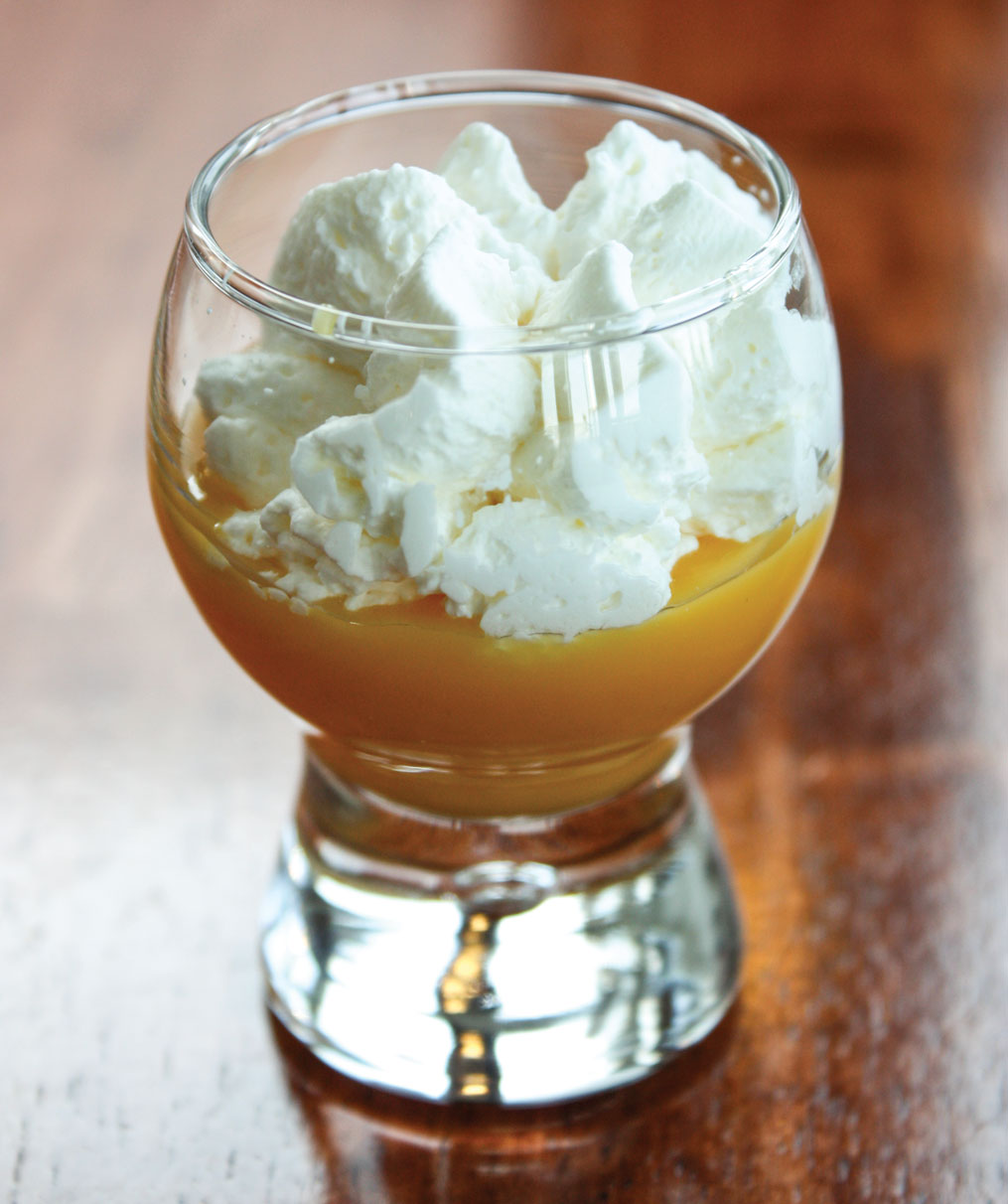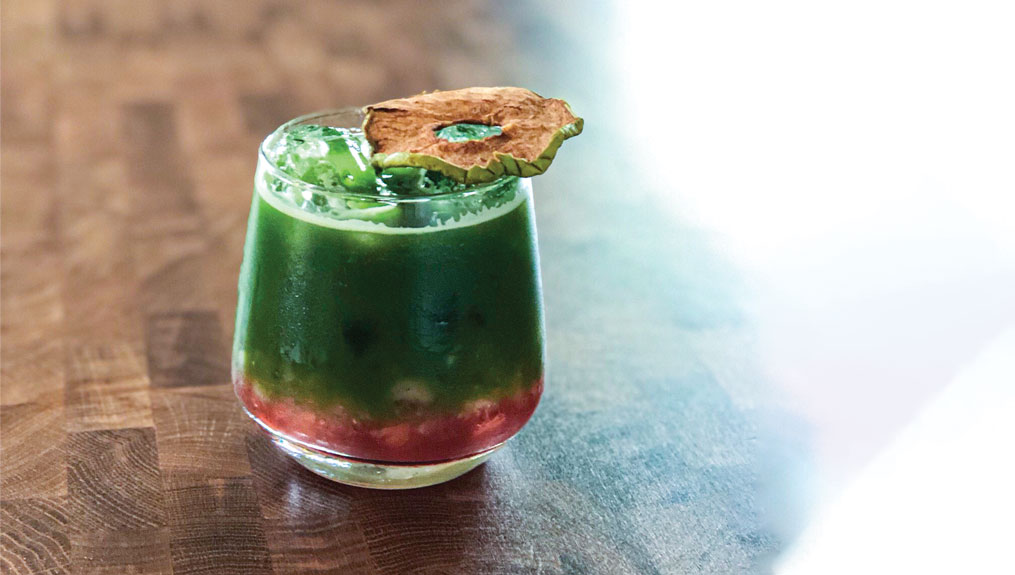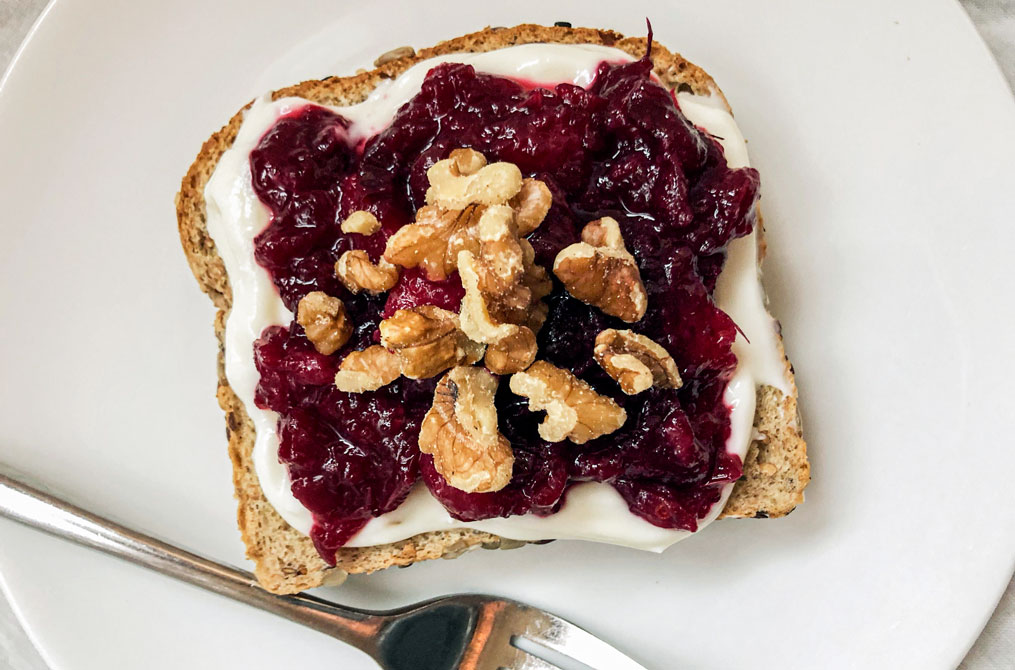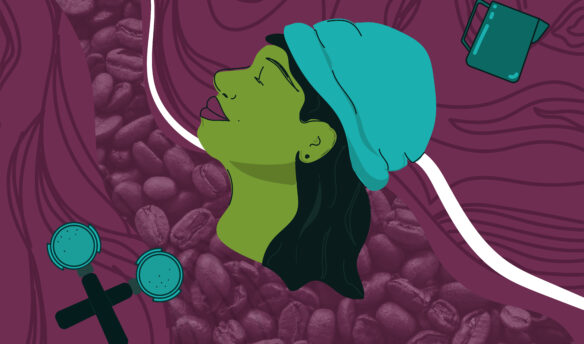Coffee Wizardz’s mocktail using Treebeard’s Tincture and matcha.
[M]y childhood is full of rich holiday food and drink traditions, from stealing pecans off of pies cooling in the laundry room to sipping made-from-scratch eggnog while decorating the Christmas tree. My mom enjoyed cooking and instilled that joy in me and my sisters. But the love reaches further back even than that. My grandmothers and great-grandmothers spent a lot of holiday time in their kitchens, and the smells, sights, and flavors were always well worth the effort, and the wait.
When I got married, my husband, Young, brought an entirely different set of food traditions—as well as a passion for coffee—into our little family, but what we have truly enjoyed over the years is creating our own seasonal rituals. Although there are a few family recipes we still dig out each year, our holiday routine now consists of always trying something new and, hopefully, delicious. As we roll into the season, you might find it easy to just go with familiar holiday flavors, like chocolate, mint, pumpkin, and maple. Let me encourage you to explore outside the flavor box and discover something fresh and tasty for yourself.
Expand Your Borders
In the cultural melting pot that is the United States, holiday traditions can be individual, familial, cultural, societal, religious, or a blend of any and all of these. The earth is a treasure trove of unique and complex flavors, spices, and textures, especially during holidays and celebrations. My first advice for spicing up your holidays is to look to other cultures for inspiration.
Although Thanksgiving is the sole property of the United States, many countries and peoples around the world celebrate Christmas or another December holiday, such as Hanukkah, Kwanzaa, or Boxing Day. In Germany, it is traditional to eat goose instead of turkey or beef. An English celebration isn’t complete unless there’s a Christmas Pudding on the table. And in Chile, families sip a cold milk punch comprised of milk, sugar, coffee, cloves, and aguardiente (a Chilean grape alcohol).
When you begin to explore other cultures, you soon discover that there are many similar, yet different, recipes, especially for drinks. The Puerto Rican coquito, Dutch advocaat, and Turkish sahlep are all milk-based drinks, like the American classic eggnog. Glögg in Scandanavia, glühwein in Germany, and wassail in the U.K. are indigenous versions of mulled drinks passed down from antiquity. With a simple swapping of spices, sweeteners, dairy, or other ingredients in your traditional holiday libations, you can create a unique holiday experience for you, your guests, or your customers.

Mix Up Your Flavors
Chocolate, mint, apple, cranberry, and maple have long histories as holiday flavors. Then, in 2003, Starbucks overhauled our idea of fall and holiday flavors with the introduction of the pumpkin spice latte, or PSL. It’s a fact that people either love or hate pumpkin, but this luscious little drink gave the familiar orange squash a whole new life. Now, we have everything from pumpkin spice cereal to pumpkin spice dog snacks, and the annual release of the PSL at Starbucks has become a renowned social media event. It’s hard to compete, as a café owner and as a home cook. Still, the pumpkin spice fixation is undeniable.
One way to mix it up is to combine a traditional flavor with a non-traditional one. One of my favorite holiday recipes that illustrates this is a quince cranberry sauce that I picked up from my local natural food store and made my own. This piquant recipe is simple and utilizes seasonal produce in an uncommon way. It’s perfect spread on a thick slice of walnut sourdough toast with a smear of cream cheese. (Click here for the recipe.) Another example: Last fall, Young and I served a maple black lime latte at our mobile café, Coffee Roboto. Espresso. Milk. Maple syrup. Ground black lime, or loomi, a Middle Eastern dried lime. Some customers hesitated, but once they tried it, their taste for adventure was instantly amplified.
Another approach is to treat traditional ingredients in a new, fresh way. Bake up a batch of fruitcake scones by combining spices like cardamom, ginger, and cinnamon with dried fruit and nuts. Concoct an apple shrub syrup, then combine it with hot mint tea and lemon for a toddy twist. Make cranberries savory with coriander, and oranges with chipotle powder.
Substitutes & Alternatives
Dairy-free, vegetarian, vegan, paleo, keto, and other diets continue to cycle through our society. At the heart of all of these is the desire to live healthier and find a more environmentally friendly approach to our use of the earth. As a result, products that appeal to these diets, intolerances, and food allergies have significantly increased over the past decade, and are projected to reach revenues of more than $38 billion by 2024. According to a March 2019 agribusiness report from Report Buyer, sales of non-dairy creamer alone increased 131% in 2018. Much of this is due to the parallel advancing popularity of veganism, vegetarianism, and reducetarianism (the reduction of animal food products). This doesn’t mean that the consumption of animal dairy will cease to exist. However, the trend can’t be ignored, and, in my opinion, it deserves to be explored to its fullest.
Alden Kelley manages the West for Gourmet Source, a sales and consulting group representing specialty beverage companies including Pacific Foods. Kelley has successfully used Pacific’s Barista Series Coconut beverage to adapt a Puerto Rican coquito, normally made with rum, coconut milk, and sweetened condensed milk, into a café drink.
“Adapted for the café,” he says, “it’s important to choose the right vanilla syrup or extract, cinnamon, and espresso that will emulate the rich fruit and caramel notes missing from the lack of rum.”
He has also experimented with replacing eggs with plant-based gums, like xanthan (bacteria fermented from corn) and agar (seaweed), to add texture to oat milk and almond milk nogs. Kelley adds, “Our Barista Series Oat, Almond, and Hemp Plant-Based Beverages have creamy flavor and a rich mouthfeel that lend well to eggnog, Tom & Jerry, Brandy Alexander, coquito, or generally warm-spiced seasonal drinks.”
Oat milk is an excellent non-dairy addition to fall flavors and goes well with all the seasonal spices, sugars, and produce, creating that satisfying creaminess we often crave as the weather turns frosty. Try it in a Salted Cinnamon Oat Latte (click here for recipe, courtesy of Pacific Foods) or whip it into a foam and spoon on top of a mulled cider or citrus cranberry punch.
Sans Alcohol
The “sober curious” or “sober sometimes” movement has gained momentum in the last few years, resulting in the rise of dry bars, more serious “mocktail” menus, and sophisticated non-alcoholic distilled spirits, like MeMento, Three Spirit, and Seedlip. Birthed out of the historic tradition of alchemy and distilled herbal remedies, Seedlip has curated the art of non-alcoholic distilled spirits and created a new standard for “what to drink when you’re not drinking.” The sober scene is quickly moving beyond curiosity and into a cultivated art that builds on mixology and craftsmanship to create a complex experience anyone can enjoy.
With one foot in coffee and one foot in “different, yet familiar, beverages,” Milwaukee-based Coffee Wizardz is jumping headfirst into the craft of elegant and intriguing non-alcoholic drinks, as well as singular café foods. Co-founders Sam Brown and Chris Christen believe in only conjuring drinks and foods where you can “taste, smell, and/or see every ingredient.” A little over a year ago, they launched their first pop up at Discourse: a Liquid Workshop in Sister Bay, Wisconsin, which claims to be a platform for “the Fourth Wave of coffee.” Since then, they have hosted novel pop-up experiences and launched a successful Kickstarter to buy a Mill City coffee roaster and roast their own coffee.
According to Brown, the Wizardz’s craft philosophy is this: “It has to be fun, and it has to make someone go, ‘whoa.’” Exploring the fringes of what is possible with coffee, tea, shrub syrups, other artistic liquids, uncommon-yet-common ingredients, dramatic visuals, creatively complimentary garnishes, and something called “spherified coffee balls,” they are well on their way to establishing a new level of whoa-factor in both the coffee community and the overarching beverage world. Check out their social media pages and website for a taste of their creations, and click here for their recipe for Vegan Pumpkin Pie with Coffee (Spheres).
You Do You
As you take a thoughtful look at your holiday season, with all the stress, joy, work, and partying waiting for you, consider taking one recipe and changing one thing about it. Give it a test run before you spring it on someone else, but at least take a risk on one thing. Once successful, you will find your imagination quickened and your palate stimulated for further toothsome adventures.
Click the links below for recipes mentioned in this article:
Quince Cranberry Sauce
Salted Cinnamon Oat Latte
Mini Vegan Pumpkin Pies with Coffee (Spheres)


















